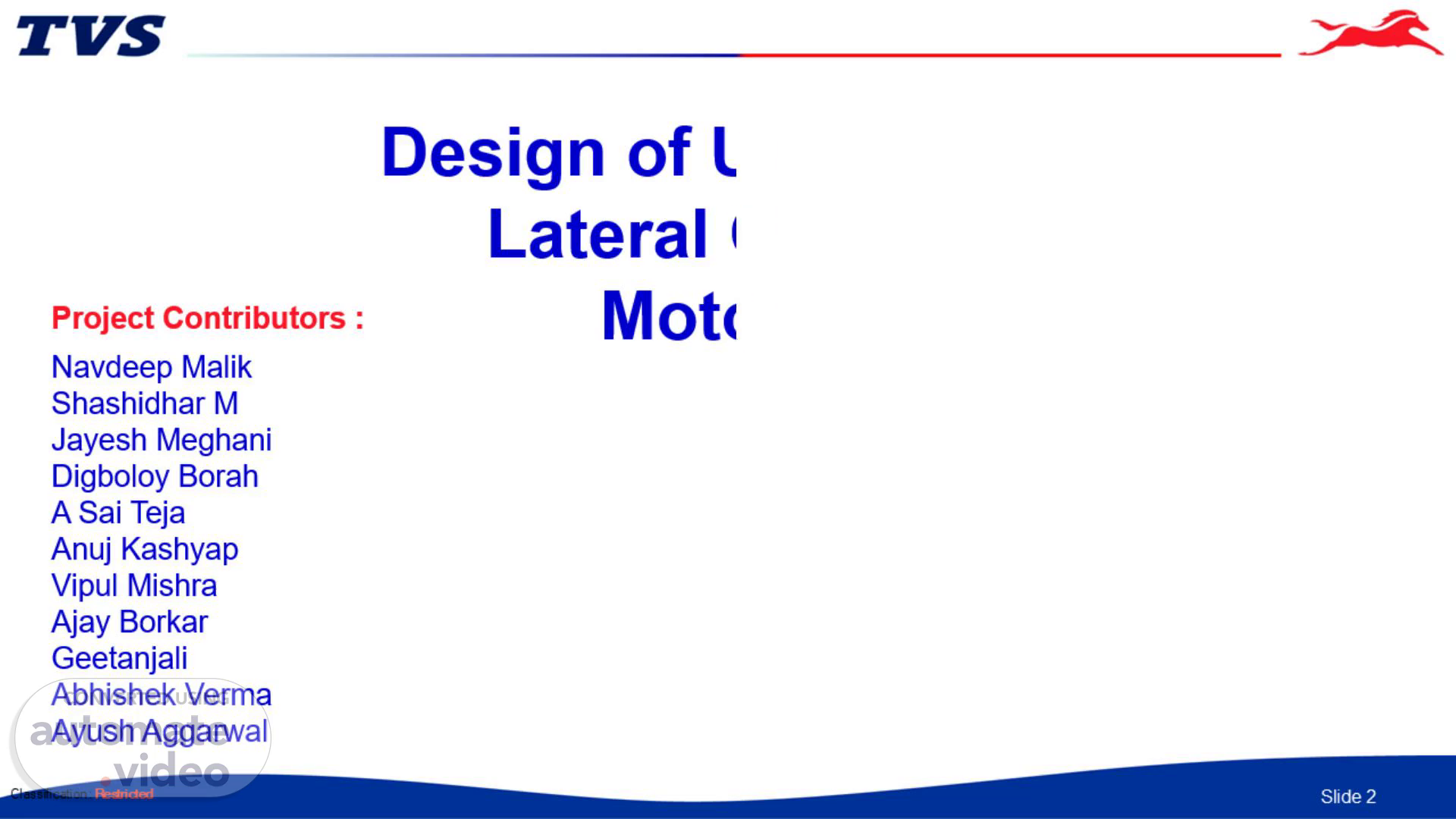Scene 1 (0s)
Design of Universal Fixture for Lateral CG Measurement of Motorcycle and Scooter.
Scene 2 (15s)
Project Workflow. Week 1 Week 2 Week 5 Week 8 Analysis of already existing technique to measure lateral CG Final Presentation Material Finalizing and Prototyping Model Development Literature Survey Week 3, 4 Idea Generation Week 6, 7.
Scene 3 (27s)
Objective of Project. Current method of measuring lateral CG of vehicles presents several limitations, including: Time Consuming Tedious Prone to errors Poor repeatability Requires multiple personnel Thus, a new method is required that overcomes the above limitations..
Scene 4 (40s)
Measurement of lateral cg of iQube ST using current method.
Scene 5 (47s)
Current Method - Calculations. 55 kg. 61 kg. 116 kg.
Scene 6 (59s)
Numerical Calculations. Using moment balance, Σ F*d = 0.
Scene 7 (1m 7s)
proposed ideas.
Scene 8 (1m 13s)
Idea-4. A diagram of a motorcycle Description automatically generated.
Scene 9 (1m 20s)
Idea-4. Idea Briefing Vehicle is balanced to perfectly vertical position by connecting a circular clamp with handle grips. Clamp is connected to vertical strain gauge (load cell) through hinge and rigid links. Once vehicle is vertical, one strain gauge will show max value and other will show some negligible value..
Scene 10 (1m 36s)
Idea-4. Assumptions Both front and the rear tyres need to be perfectly aligned (wheel aligners). Both left and the right links are perfectly aligned with each other (line of action of forces on both strain gauges is same). Ground need to be perfectly horizontal..
Scene 11 (1m 51s)
Idea-4. A drawing of a machine. Isometric view. CAD Design.
Scene 12 (1m 58s)
Idea-4. A drawing of a machine Description automatically generated.
Scene 13 (2m 10s)
A white sheet with black text Description automatically generated.
Scene 14 (2m 24s)
Idea-2. Primary Concept Design. A diagram of a machine Description automatically generated Strain Gauge Front wheel Wheel aligners.
Scene 15 (2m 37s)
F1 (Strain gauge). F2 (Strain gauge). R1. W. w. w.
Scene 16 (2m 46s)
Idea-2. Idea Briefing 2 strain gauges (with position adjustment) mounted on wheel aligners (bars). (1L,1R) C-clamps are connected to wheel aligners. Wheel aligners are connected to vertical strain gauges (load cells) through straight rigid links. By adjusting the length of links via screw thread mechanism, the vehicle need to be inclined at angle corresponding to position where both of strain gauges show equal values..
Scene 17 (3m 5s)
Idea-2. Assumptions Both front and the rear tyres need to be perfectly aligned (wheel aligners). Vertical CG of the vehicle should be known. Both left and the right links are perfectly aligned with each other (line of action of forces on both strain gauges is same). Ground need to be perfectly horizontal..
Scene 18 (3m 21s)
Idea-5. A diagram of different types of objects Description automatically generated.
Scene 19 (3m 30s)
Idea-5. A group of motorcycles parked in a garage Description automatically generated.
Scene 20 (3m 38s)
20. Front view. X. Y. W1. W2. W3. W4. W. dX. x1. x2.
Scene 21 (3m 55s)
A blue rectangular object with red lines Description automatically generated.
Scene 22 (4m 6s)
Idea-5. Idea Briefing Vehicle need to be balanced By central stand. By Floor mounting, like Vehicle Layout Machine. Platform mounted are on four load cells placed symmetrically. Once the vehicle is perfectly vertical, the weight distribution on left and right side load cells can be used for moment balancing to give location of lateral CG..
Scene 23 (4m 23s)
Idea-5. Assumptions Both front and the rear tyres need to be perfectly aligned along center line of platform. Vehicle needs to be perfectly vertical..
Scene 24 (4m 33s)
Withheld IDEAS.
Scene 25 (4m 39s)
Idea-1. Front View. Side View. A diagram of a machine Description automatically generated.
Scene 26 (4m 50s)
Idea-1. Idea Briefing 2 strain gauges (with position adjustment) mounted on seat. (1L, 1R) Two independent bars clamped around both tyres to restrict the motion of front wheel. Inverted U-shaped frame connected with clamping bars, that will consist of perfectly horizontal top plate over which precise angle measurement sensor can be mounted. With help of accurate tilt angle and Vertical CG (known), lateral CG can be calculated with high accuracy..
Scene 27 (5m 11s)
F1. F2. R1. W. w. Idea-1. FBD. Front view.
Scene 28 (5m 21s)
Idea-1. Assumptions The CG of inverted U-shaped frame is at its geometrical center. The weight of frame needs to be as minimum as possible, to minimize the impact on overall moment (which is measured by strain gauges). The top plate mounted on frame is perfectly horizontal..
Scene 29 (5m 36s)
Idea-3. Dynamic Gravity Mapper. System consist of three main parts, namely the spherical bearing support, flexible arm support set up and a plate mount for the assembly. Sphere bearing set up consist of two accelerometer for lateral and longitudinal displacement of CG in terms of angle. Flexible arm could be adjustable for any shape and design of Bike. The plate mount is adjusted on the top of the support set up..
Scene 30 (5m 57s)
Idea Briefing As shown on the figure the bike is adjusted via flexible support and a main stronghold from the top of the celling, the deflection (based on clamping of the bike) could be seen as an angle from both sensors mounted on the spherical joint set up. The Bike will tend to tilt in both direction and as the CG of the bike lies below the CG of the whole system projecting a stable condition too..
Scene 31 (6m 18s)
Idea-3. Assembly figure (simple diagram and main assembly).
Scene 32 (6m 29s)
A notebook with writing on it Description automatically generated.
Scene 33 (6m 36s)
Thank You.
